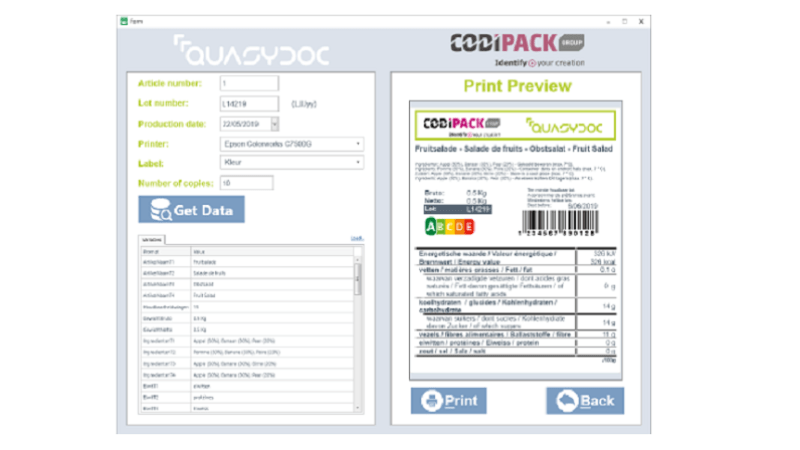What should be on a food label?

When walking through the rows of shops, consumers will never find an unidentified product. A product without a label is not in order legally, and it is also important that people have correct product information. The transparency that can be found on the label serves as protection for the consumer. Therefore, it is important that every food product has a clear label. In order to ensure that each product is provided with the correct information, legislation has laid down strict rules for this. The Belgian legislation on labelling is based on the European legislation. The rules determine what information must appear on a label. Each statement must be easy to understand, clearly legible, visible and indelible. The statements can be applied directly to the packaging or by means of a label.
Mandatory entries:
1. Sales denomination
The sales description helps to identify the product. Thanks to the name, it must be immediately clear to the consumer which product it is. Therefore, it is important to use a clear and objective name.
2. Ingredient list
The list of ingredients shall include all the ingredients present in the finished product. It shall be in descending order of weight and preceded by the word ‘ingredients’. It is important that each ingredient is referred to by its specific name. An ingredient can be a foodstuff, food component or additive, such as preservatives, flavourings and colourings. The list gives a clear indication of the composition of the product.
3. Allergens
Some ingredients can cause an allergic reaction when consumed, inhaled or contacted. It is therefore very important that it should be immediately obvious if a product contains an allergen. In order to ensure that consumers who are hypersensitive to certain food ingredients are properly informed, it is compulsory to include allergens prominently in the list of ingredients.
In total, there are 14 ingredients that must be specifically identified:
- Cereals containing gluten: wheat, rye, barley and oats
- Egg
- Fish
- Peanut
- Nuts: almonds, hazelnuts, walnuts, cashew nuts, pecan nuts, brazil nuts, pistachios and macadamia nuts
- Soybean
- Milk, including lactose
- Shellfish
- Molluscs
- Celery
- Mustard
- Sesame seed
- Sulphur dioxide
- Lupine
4. Quantity
The packaging must always show the quantity of the product. This is therefore always the net product content. The weight of the packaging never counts. The quantity is expressed in number of pieces, units of volume for liquid products (millilitres, litres, etc.) and units of mass (grams, kilograms, etc.) for other products.
5. Expiry date
A best-before date tells the consumer how long the product will keep its desired quality. It thus indicates until when the product is fit for consumption.
For products with a shelf life of less than 3 months, the date consists of both the day, month and year. For products with a shelf life of between 3 and 18 months, the date only consists of the month and year. If the product has a shelf life of more than 18 months, only the year will suffice. The best before date is always preceded by ‘Best before’.
Products which spoil very quickly will be given a use-by date instead of a best-before date.
6. Storage instructions and conditions of use
Some expiry dates depend on the environment in which the product is used or stored. If the product is in an unsuitable environment, this increases the risk of spoilage and pathogenic bacteria.
To prevent this, the specific storage instructions and conditions of use must be stated on the packaging.
For example: ‘keep cool’, ‘do not refreeze after defrosting’, ‘open 20 minutes before use’.
7. Instructions for use
If the product is difficult to use without instructions, the instructions must be attached to the packaging.
8. Data responsible
The product must always carry the (business) name and address of the person responsible for the product. This may be the manufacturer, packer or seller.
9. Batch/lotnumber
These codes are essential for product traceability. Thanks to the unique numbers, producers can easily identify products and trace their production process. The numbers allow producers to see where the product has been produced, manufactured and packaged. They can trace the entire process from source to final destination. This makes it much easier if products have to be recalled, quality controls carried out or products quarantined.
10. Nutritional value
The nutritional value indicates how much energy the product contains. In addition to the energy values, it also indicates the nutrients contained in the food. The amounts of fat, saturated fatty acids, carbohydrates, sugars, proteins and salt are always expressed per 100 ml or 100 g.
11. Alcohol percentage
As soon as a drink has an alcoholic strength of more than 1.2 %, the actual alcoholic strength by volume must be stated on the packaging. The indication shall always comprise a figure and at most one decimal place, followed by “% vol”.